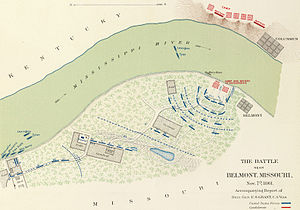
Back Bitva u Belmontu Czech Slaget ved Belmont Danish Bataille de Belmont (1861) French Belmonti ütközet (1861) Hungarian Battaglia di Belmont (1861) Italian ベルモントの戦い Japanese ბელმონტის ბრძოლა Georgian Slag bij Belmont (Missouri) Dutch Bitwa pod Belmont Polish 伯蒙特之役 Chinese
| Battle of Belmont | |||||||
|---|---|---|---|---|---|---|---|
| Part of the Trans-Mississippi Theater of the American Civil War | |||||||
 Charleston defenses, Belmont battlefield by Julius Bien & Co., Lith., N.Y. | |||||||
| |||||||
| Belligerents | |||||||
|
|
| ||||||
| Commanders and leaders | |||||||
| Ulysses S. Grant | Leonidas Polk | ||||||
| Strength | |||||||
| 3,114 | 5,000 | ||||||
| Casualties and losses | |||||||
|
607 (120 killed; 383 wounded; 104 captured/missing) |
641 (105 killed; 419 wounded; 117 captured/missing) | ||||||
The Battle of Belmont was fought on November 7, 1861, in Mississippi County, Missouri. It was the first combat test in the American Civil War for Brig. Gen. Ulysses S. Grant, the future Union Army general in chief and eventual U.S. president, who was fighting Major General Leonidas Polk. Grant's troops in this battle were the "nucleus" of what would become the Union Army of the Tennessee.[5]
On November 6, Grant moved by riverboat from Cairo, Illinois, to attack the Confederacy's small outpost near Belmont, Missouri across the Mississippi River from the Confederate stronghold at Columbus, Kentucky. He landed his men on the Missouri side and marched to Belmont. Grant's troops overran the surprised Confederate camp and destroyed it. However, the scattered Confederate forces quickly reorganized and were reinforced from Columbus. They counterattacked, supported by heavy artillery fire from across the river. Grant retreated to his riverboats and took his men to Paducah, Kentucky. The battle was relatively unimportant, but with little happening elsewhere at the time, it received considerable attention in the press.[6]
- ^ "Belmont". American Battlefield Trust.
- ^ Roberts II, Donald J. "Battle of Belmont: Ulysses S. Grant's First Battle". Warfare History Network.
- ^ "Battle of Belmont". National Park Service.
- ^ "The Battle of Belmont A State Divided". The Historical Marker Database, Belmont Battle Marker; Belmont Missouri.
- ^ John Aaron Rawlins, 1866 Address, Report of the Proceedings of the Society of the Army of the Tennessee (Cincinnati: F.W. Freeman, 1877), pp. 24, 28.
- ^ Grant, Ulysses. The Personal Memoirs of Ulysses S. Grant (The Complete Annotated ed.). Ulysses S. Grant Association. p. 197.